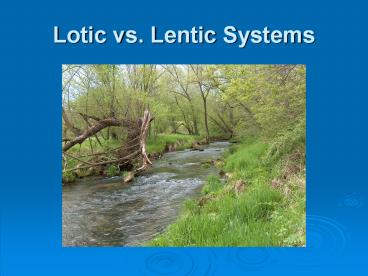Lotic vs. Lentic Systems - PowerPoint PPT Presentation
Title:
Lotic vs. Lentic Systems
Description:
Title: Fish in Lakes Author: Neal Mundahl Last modified by: Joe Whetstone Created Date: 11/20/2005 11:09:25 PM Document presentation format: On-screen Show – PowerPoint PPT presentation
Number of Views:3937
Avg rating:3.0/5.0
Title: Lotic vs. Lentic Systems
1
Lotic vs. Lentic Systems
2
Comparisons
- Surface area - 1/18th that of lakes
- Age - most stream channels ancient compared to
most lakes - Flow - the most influence on making stream
environments different than lakes
3
Flow
- Produces structure of river, bed, influences
biota - Currents vary seasonally, longitudinally,
vertically
4
Flow
- Generally lt3 m/sec (up to 8 m/sec)
- Maximal during greatest runoff (wetter season)
5
Flow
- Current speed decreases as depth increases
- Decrease from mid-channel to edges (frictional
forces between water, substrate - produce
boundary layer)
6
Flow
- Average velocity at 0.6 depth for shallow streams
(or average of readings at 0.2 and 0.8 depth in
deeper streams or rivers)
7
Flow
- Velocity generally decreases from headwaters to
mouth - Headwaters - erosional - larger substrates
- Near mouth - depositional - smaller substrates
8
Flow
- General pattern not always present
- Velocity may be constant, or may increase
9
Alternating Habitats
- Riffles and pools
- Faster currents in riffles
- Regular spacing - riffles 5-7 stream widths apart
10
Water Temperatures
- More rapid changes than in lentic waters
- Daily cycles up to 6º C in summer
- Average temperatures tend to increase downstream
11
Water Temperatures
- Little stratification because of flows
- Warmer temps alter viscosity
- Faster flow
- Carry less silt
- Reduces boundary layer
12
Water Temperatures
- Winter - entire stream declines to 0º C before
ice forms - Ice formation at any layer
- Frazil or anchor ice
13
Light Penetration
- Less in moving vs. standing waters
- Increased turbidity
- Increased shading by riparian vegetation
14
Chemistry
- Dependent on drainage basin
- General inverse relation between discharge and
concentrations of dissolved materials
15
Chemistry
- Little zonation of dissolved materials or gasses
- Turbulent flow, gasses at saturation for temp.,
pressure - Significant changes by activities of living
organisms
16
Biota
- Phytoplankton in streams relatively meager
- Few planktonic forms
- Mostly benthic forms
17
Biota
- In larger streams, plankton always present
- Planktonic diatoms dominate
- Selective elimination of other types?
18
Biota
- Most primary production in small streams from
periphyton growing on bottom - Unusually productive because of nutrient delivery
19
Biota
- Zooplankton numerous only in larger systems
- Dominated by rotifers
- Few crustacean zooplankters
20
Biota
- Benthic invertebrates diverse (especially
insects) - Substrate is major controlling factor
21
Biota
- Soft substrate types found in both flowing,
standing waters - Hard substrate types often unique
- Adaptations to cope with flowing water
(flattening, hooks, suckers, secretions, ballast)
22
Biota
- Longitudinal rather than depth zonation
- Changes in response to temp., current, food
availability
23
Biota
- Fish exhibit distinct habitat, longitudinal
differences - Those in pools or downstream zones also found in
lakes
24
Biota
- Those in headwaters adapted for life in moving
water































